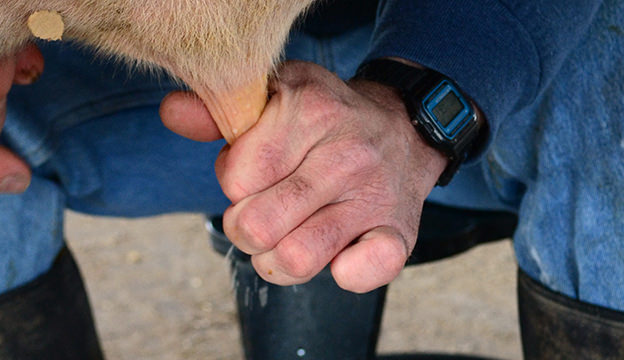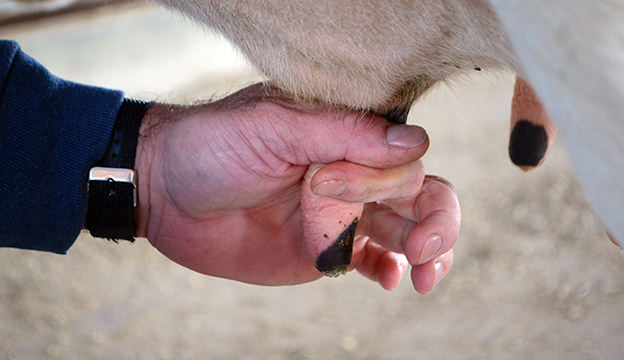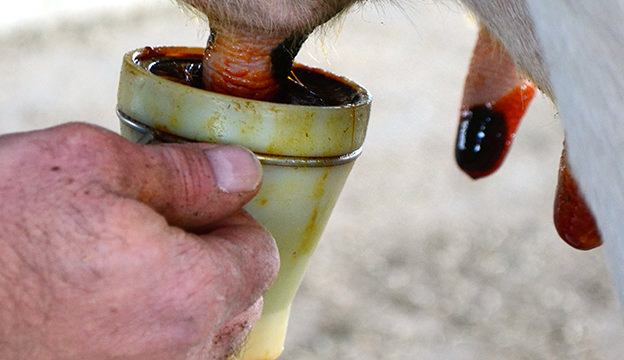
The family milk cow: It’s an iconic symbol of rural living, though many small-scale farms have veered away from raising a dairy cow for their family’s milk, butter and cheese needs. While adding a family dairy cow with its traditional twice-daily milkings to your farmstead will surely add another chore to your to-do list, it can be a great way to keep tabs on what’s in your kitchen’s dairy products and help you transition to a more sustainable, self-supporting lifestyle.
The first step to getting quality milk from your dairy cow is ensuring you feed it a nutritious diet comprised of water, roughage and grain. Giving your cow enough clean water is of utmost importance, as milk is approximately 87 percent water. Allen Young, dairy specialist at the Utah State University Cooperative Extension, recommends providing up to 30 gallons of water per day and serving it at lukewarm temperatures if possible.
If you’re able to pasture, provide each dairy cow with 1 to 3 acres. Rid the pasture of poisonous plants and plants that will taint the milk, such as wild onions, advises Robby Dale Estes, assistant dairy manager at Eastern Kentucky University’s Stateland Dairy. In the event that you cannot pasture or winter climate requires you to provide feed, supply quality hay, like alfalfa or clover, as it can be stored longer than other roughages, like corn silage. A 1,000-pound cow will consume about 2 to 2½ pounds of hay daily, Young says, but this will not fulfill all its nutritional needs. Round out your cow’s diet with a 16- to 20-percent-protein grain. Your cow will need slightly less than 3 pounds of grain for each gallon of milk it produces daily.
Another key component in getting quality milk is making sure the cow is up-to-date on its vaccinations, such as tuberculosis and brucellosis. Talk with your veterinarian about what vaccinations are necessary and safe for milk cows. Finally, make sure all the supplies you are use during milking are clean. Use a plastic or stainless-steel bucket, Estes says, and sanitize it with bleach before each use.
Milking Instructions
While modern dairies, even those on a small scale, use milking machines, if you have one or two cows, you’ll likely stick to hand-milking. Follow these instructions to properly hand-milk your family dairy cow:
Step 1

Tie the cow in a clean, dry, stress-free environment.
Step 2

Before milking your cow, observe the udder and teats for any signs of mastitis, such as swollenness or fever. Mastitis is a disease in dairy cows that can be caused by a number of different pathogens and that can affect the production and quality of milk. Often mastitis symptoms aren’t readily apparent through visual or tactile observation, but it’s best practice to know what looks normal for your cow and what could be symptoms of disease.
Step 3

Strip out each teat by performing three to four squirts each. (See steps 6 and 7 for proper technique.) Stripping allows you to remove dirt and bacteria from the teat as well look for signs of infection, such as clumps, clear milk and blood, any of which could indicate mastitis.
Step 4

Apply a pre-milking disinfectant to the teats to help prevent mastitis. Leave the disinfectant on the teats for approximately 30 seconds. (There are different types of pre-milking disinfectants on the market, so make sure to follow the manufacturer’s instructions for use.)
Step 5

Wipe the pre-milking disinfectant off of each teat with a single-use towel.
Step 6

Now you’re ready to begin milking. Properly hold the teat by wrapping your thumb and forefinger around the base of the teat. This captures the milk in the teat.
Step 7

Loosen the grip of the finger and thumb, and gently squeeze to release the milk.
Step 8

Repeat steps 6 and 7 on each teat. If there is no calf, milk until the udder is completely depleted of milk to prevent mastitis.
Step 9

If the cow is feeding a calf, you can return the cow to pasture, as the calf will finish cleaning and disinfecting the teats. However, if your cow doesn’t have a calf, immediately apply a post-milking disinfectant to the teats. This solution performs a different function than the pre-milking disinfectant and each should be clearly labeled. Use of a post-milking disinfectant reduces the rate of mastitis by 50 percent, according to the National Mastitis Council. Follow manufacturer’s guidelines for use.
Step 10

Leave the post-milking solution on the teats. Do not remove with a towel.
Raw Milk vs. Pasteurized Milk
One highly controversial topic surrounding milk is raw versus pasteurization.
“If you know your cow, it’s probably OK to drink its raw milk,” Estes says, as you know its health conditions, what vaccinations it’s received and the cleanliness of the equipment used during milking.
However, it’s advised that milk be pasteurized to remove any food-borne pathogens that might be present in the milk. Home-pasteurization kits are the preferred way to home-pasteurize your milk. You can also use materials you already have in your kitchen, such as a double-boiler system, to pasteurize on the stovetop, though you must take care to maintain milk temperature for a specific period of time. Here are two home-pasteurization methods offered by the South Dakota State University Cooperative Extension Service.
Pasteurization Method 1: Batch Method
- Prepare an ice-water bath for cooling.
- Place raw milk in a double boiler. (Pasteurize 1 quart to 1 gallon milk at a time.)
- Heat milk to 145 degrees F, and maintain temperature for 30 minutes. If the temperature falls below 145 degrees F, restart the process.
- Cool milk as quickly as possible by (a) cooling it to 40 degrees F within four hours in the ice-water bath or (b) cooling it to 70 degrees F within two hours in the ice-water bath and then continuing to cool it to 40 degrees F in the refrigerator within the next four hours.
Pasteurization Method 2: Continuous High-temperature Short-time Method
- Prepare an ice-water bath for cooling.
- Place raw milk in a double boiler. (Pasteurize 1 quart to 1 gallon milk at a time.)
- Heat milk quickly until it reaches 165 degrees F and remove from heat source. As an alternative, heat milk quickly to 161 degrees F, maintain temperature for 15 seconds, and remove from heat source.
- Cool milk as quickly as possible by (a) cooling it to 40 degrees F within four hours in the ice-water bath or (b) cooling it to 70 degrees F within two hours in the ice-water bath and then continuing to cool it to 40 degrees F in the refrigerator within the next four hours.




